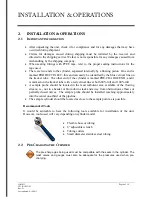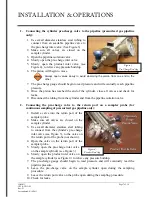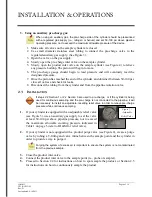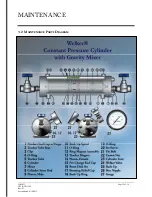
SPECIFICATIONS
IOM-013
Page 4 of 18
CP2 & CP5GM
Rev: D
Last updated: 4/14/2011
taking a pressure drop. An internal piston in the cylinder helps to purge out air and contaminants
prior to taking the sample by displacement. The stainless steel gravity-action mixer works in
conjunction with the cylinder rod; mixing is accomplished by inverting the cylinder several times.
Welker CP-2 & CP-5 Premium Purge model cylinders have valves built into the pre-charge and
product end cap ports. They are also included with product purge and pre-charge purge valves.
During the purge process, the piston is pushed to the end of the cylinder, also preventing any
other possible contaminants from entering. Burst discs and gauges are also included on each end
cap of the device. In the event that the cylinder is overpressurized, these discs will rupture,
relieving excess pressure from the cylinder. Welker CP-2 & CP-5 Premium Purge model
cylinders have valves built into the pre-charge and product end cap ports. They are also included
with product purge and pre-charge purge valves.
Adjustable relief valve (optional)
The adjustable relief valve functions as a safety device for the unit.
During continuous sampling and transportation of the cylinder, the relief
valve assures that the device maintains a constant pressure and does not
exceed maximum allowable pressure. The valve will relieve any pressure
that exceeds the set pressure.
1.3 I
MPORTANT INFORMATION
Please read the following information in its entirety before using the Welker equipment
described above. Failure to adhere to the recommendations could result in injury.
Never fill a cylinder completely full of hydrocarbon liquid or refrigerated gas. Always
allow for at least 20% expansion.
Protect the cylinder at all times and handle with care. It is a precision instrument and may
contain a flammable or hazardous product as well as a valuable representation of your
company’s product.
When analysis is complete, the cylinder should be emptied safely and in a safe area by opening
the product inlet valve, allowing the pre-charge pressure to push the piston to the product end
cap, emptying the cylinder.
Welker recommends cleaning and leak testing of the cylinders after each use.
Because of the design of the cylinder and the incorporated seals, the process of emptying the
cylinder will simultaneously wipe the walls of the device clean. The end cap will also be
purged clean with the next use.
Never transport a cylinder with pressure exceeding D.O.T. regulations (see U.S. Government
CFR 49 for D.O.T. regulations).
In cases where the cylinders are exposed to varying
temperatures, do not allow the cylinder to exceed the maximum allowable operating
pressure indicated in Table 1 on page 5.
Figure 2
Figure 1



















